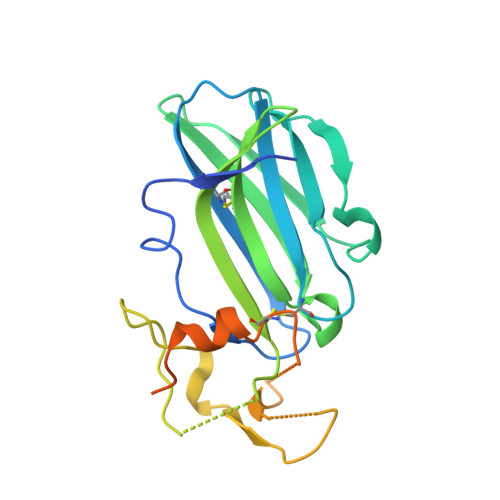The structure of cytomegalovirus immune modulator UL141 highlights structural Ig-fold versatility for receptor binding.
Nemcovicova, I., Zajonc, D.M.(2014) Acta Crystallogr D Biol Crystallogr 70: 851-862
- PubMed: 24598754
- DOI: https://doi.org/10.1107/S1399004713033750
- Primary Citation of Related Structures:
4JM0 - PubMed Abstract:
Natural killer (NK) cells are critical components of the innate immune system as they rapidly detect and destroy infected cells. To avoid immune recognition and to allow long-term persistence in the host, Human cytomegalovirus (HCMV) has evolved a number of genes to evade or inhibit immune effector pathways. In particular, UL141 can inhibit cell-surface expression of both the NK cell-activating ligand CD155 as well as the TRAIL death receptors (TRAIL-R1 and TRAIL-R2). The crystal structure of unliganded HCMV UL141 refined to 3.25 Å resolution allowed analysis of its head-to-tail dimerization interface. A `dimerization-deficient' mutant of UL141 (ddUL141) was further designed, which retained the ability to bind to TRAIL-R2 or CD155 while losing the ability to cross-link two receptor monomers. Structural comparison of unliganded UL141 with UL141 bound to TRAIL-R2 further identified a mobile loop that makes intimate contacts with TRAIL-R2 upon receptor engagement. Superposition of the Ig-like domain of UL141 on the CD155 ligand T-cell immunoreceptor with Ig and ITIM domains (TIGIT) revealed that UL141 can potentially engage CD155 similar to TIGIT by using the C'C'' and GF loops. Further mutations in the TIGIT binding site of CD155 (Q63R and F128R) abrogated UL141 binding, suggesting that the Ig-like domain of UL141 is a viral mimic of TIGIT, as it targets the same binding site on CD155 using similar `lock-and-key' interactions. Sequence alignment of the UL141 gene and its orthologues also showed conservation in this highly hydrophobic (L/A)X6G `lock' motif for CD155 binding as well as conservation of the TRAIL-R2 binding patches, suggesting that these host-receptor interactions are evolutionary conserved.
Organizational Affiliation:
Division of Cell Biology, La Jolla Institute for Allergy and Immunology, 9420 Athena Circle, La Jolla, CA 92037, USA.















